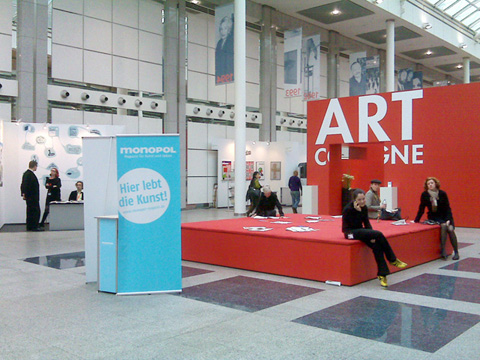Art Cologne 2008 gets ready for (no) business
Yes, I have been guilty of such disingenuousness myself on more than one occasion, but let it be known, after the marathon ten-hour opening and nearly week-long Art Cologne (probably the longest fair of them all), we have sold absolutely nothing. Not a work, not a drawing, not a photo, not a thing.
Back at the hotel, the church bells of Cologne’s almighty gothic Dom church resounded through the square, and I grieved for the viable fair that once was Art Cologne. The fair was the first, it grew and flourished and the idea spread, and as it caught on elsewhere it began to be overshadowed and a diminishment took hold that now approaches an end point, like an ever-repeating cycle of life. I suppose it should be no surprise.
In 1991, the Dom itself emblazoned the cover of the New York Times Sunday Magazine section with a headline that read, in so many words, “What Is the Center of the Art World: Cologne or New York?” Then a funny thing happened on the way to the forum, namely a deep U.S. recession followed on its heels by Germany’s own cyclical downturn. Next, lo and behold, unforeseen by all, the upstarts Damien Hirst, Charles Saatchi and Jay Jopling forever changed the course of art commerce and content — for the time being at least — launching a revolution in young British art.
Never before had an art boom had such glamour, in any case not since the decade before. But one thing had happened since the ‘80s boom-and-bust, and that was the fall of global communism, which brought so many more capitalists into the art-collecting fold. Thanks be that they even like the stuff, but they do. In the last ten years the art market has experienced more growth than in the previous 100 years altogether, but now we are on the verge of a setback, and a possibly monumental one at that.
Perhaps a correction might be a good thing regarding art fairs, as these events have become emblematic of an increasingly bloated global art world. We have recently witnessed the demise of the Düsseldorf Contemporary fair, the Frankfurt fair, the Mallorca version of the Cologne fair (an anemically attended event in a Spanish airport in the dead of summer — hello?) and surely a few more will bite the dust in the coming months.
And how has all this affected Art Cologne? Well, badly. A new director was brought in a few years ago, but his initiatives — more this, less that — could only do so much. Moving the Cologne fair from October, when it took place on the heels of the Frieze Art Fair, to the spring, where it directly clashes with Art Brussels, was also no stroke of genius.
And then there was the Cologne Mutiny, effected earlier this year, no doubt the first overthrow of an art fair director via the popular press, like the pamphlets of Thomas Paine campaigning for American Independence. However, the cause in Cologne was not quite so noble or pure. A group of Cologne dealers, bemoaning their “tragic loss of status,” signed a national newspaper advertisement calling for the resignation of the fair’s director, along with a list of other petty demands.
I witnessed these antics from a seat on the Art Cologne selection committee, having been appointed to the position after being rejected and rejected and finally accepted by just about most every major fair. The notion that publicly stoning the outgoing director — a demand to which the fair management seemed amenable enough — would serve to restore the fair to its former glory is laughable and also meaningless in a wider context.
In the end, the ploy was seen as a childish act of petulance by those who couldn’t get their way through normal channels and instead ventured into the world of the popular press, where no one really cares about or pays much heed to such insignificant issues as art fairs. The real problem is that Art Cologne lost its enviable position some years ago of being the “day sale” to Art Basel’s “evening sale.” With upcoming spring auctions fast approaching, the long anticipated cracks in the market should finally begin to appear. The inevitable winnowing in the marketplace could very well lead to the demise of Art Cologne.
Would free food help lure the visitors? probably not!
Nice, clean, empty aisles at Art Cologne
Nothing wrong with the art or the architecture at Art Cologne 2008
Lots of elbow room at Art Cologne 2008
Okay, I am not wholly blameless in the downward trajectory of my own Art Cologne fortunes. Due to an assortment of mishaps, we were left without wall labels at the opening and we neglected to gauge accurately the booth configuration, failing to account for two inordinately sized exterior walls, which a neighboring gallery so kindly offered to fill for me with its own lovely photographs. Horror vacui rules the world of art fairs, where empty spaces and white walls, as little patches of fair real estate that come at a high premium, are simply not acceptable.

The Rove booth at Art Cologne 2008, with a Franz West “skirt,” a tongue chair by Peter Harvey, paintings by Zaha Hadid and drawings by Richard Artschwager

Plenty of room in front of the booth of Kenny Schachter’s Rove gallery from London
Yet, our lack of sales cannot be pinned on any lack of esthetic insight, as my booth contained stalwarts of history books and art-market favorites alike: Sigmar Polke, Vito Acconci, Richard Artschwager, Peter Saul, Franz West and the industrial designer Tom Dixon. Admittedly, this fare is a bit retrograde compared to my usual program, but what better time to do traditional than during an incipient downturn?
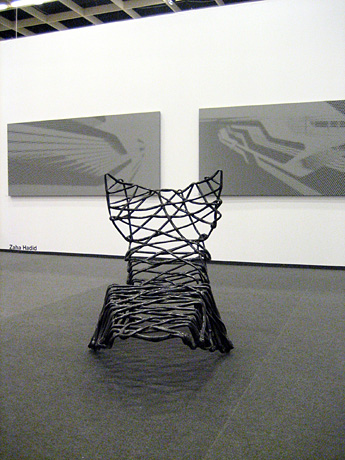
The Rove booth at Art Cologne 2008, with a chair by Tom Dixon and paintings by Zaha Hadid
The ad hoc plan we hatched for the mammoth, naked outside wall of the booth was a guerrilla installation by William Pope. L, the noted performance artist, featuring a shelf with a potted house plant that was heavily, viscously covered in many coats of black and blue spray paint till the pigment dripped off the leaves and oozed down the walls.
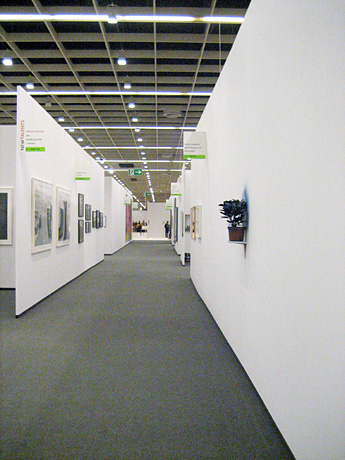
William Pope.L’s offending plant sculpture on the vast outer wall of the Rove booth at Art Cologne 2008
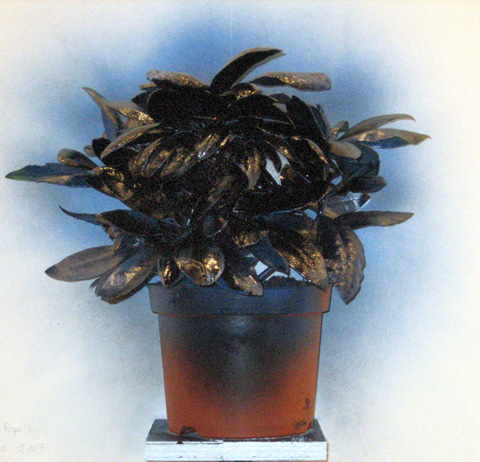
The offending plant sculpture by William Pope.L
It didn’t take long for the complaints to materialize. Though the paint didn’t smell all that much in the immediate area of the transgression, when I subsequently went for a coffee I discovered the wind patterns in the convention center had wafted a toxic cloud of fumes throughout the rest of the hall. The Art Cologne staff acted swiftly and decisively, posting a guard of three strong security officers to keep the generally absent public away from the offending spray paint.
Emergency services keeps an eye on things at Art Cologne 2008
Sitting in my Art Cologne booth, I was overcome by an eerie stillness, a feeling of listlessness, like being part of a display in a vitrine at a museum of natural history. Although we did hear reports of the occasional big-ticket sale, more than one disaffected participant stated an intention not to return. One might argue that the regional fairs remain strategic places to find material like the 1973 Polke work on paper I picked up from his series of erotic drawings. But acquisitions in the face of a no-business climate are a dangerous undertaking, like Russian roulette.
What the Cologne dealers woefully failed to recognize with their misguided newspaper petition to publicly discharge the director of the fair is that there is no simple way to restore the luster of a city or its importance in a global community that is constantly transforming and mutating. No declaration on the part of anyone, be it a politician or, even worse, a group of galley owners, can sway the march of time and the shifting balance of power. In the end, the whole affair makes you think of the title to the 1973 Sidney Pollack film starring Barbra Streisand and Robert Redford: The Way We Were.
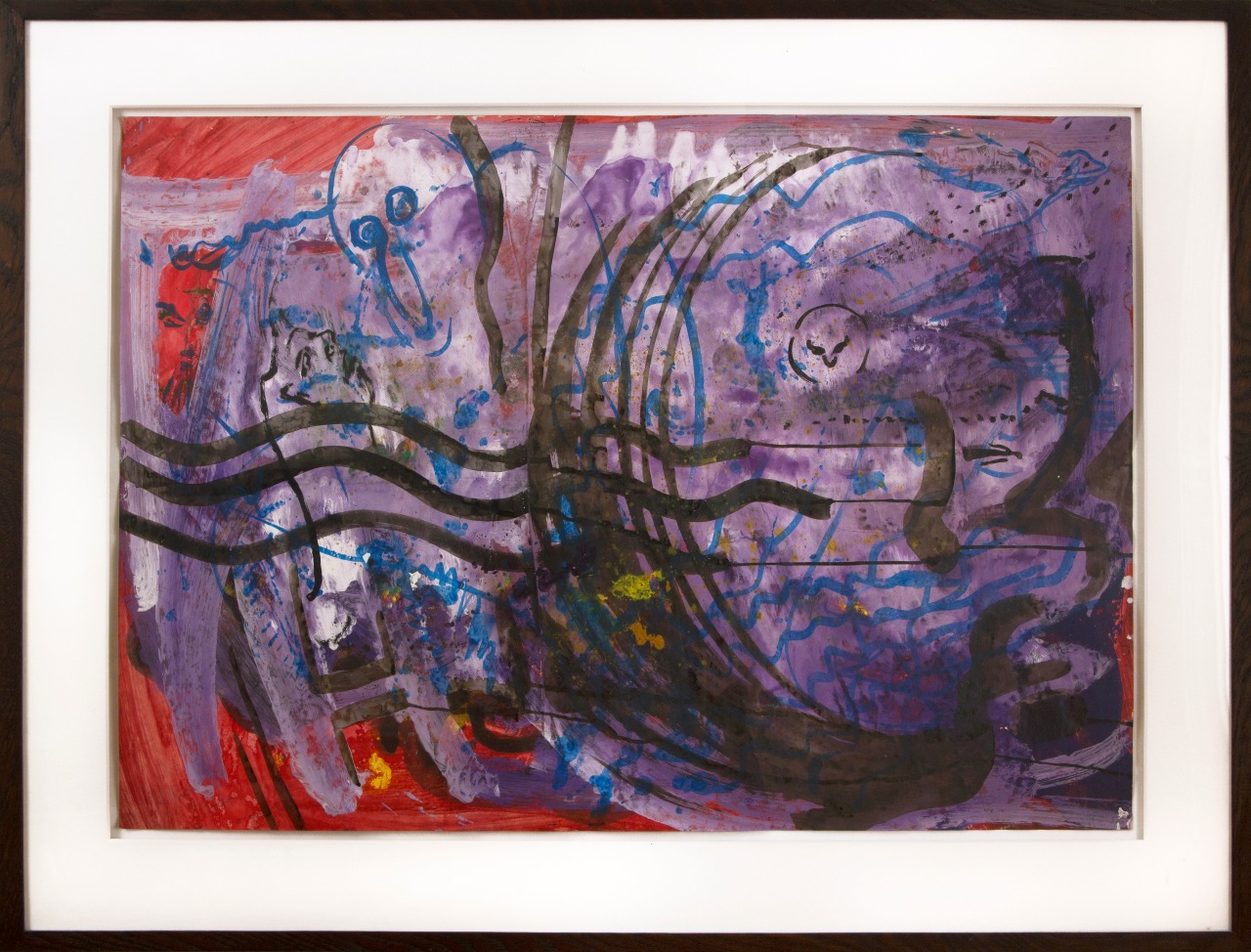
A 1982 work by Sigmar Polke, no takers
Kenny Schachter
Click here to see the original article directly on the artnet news website

